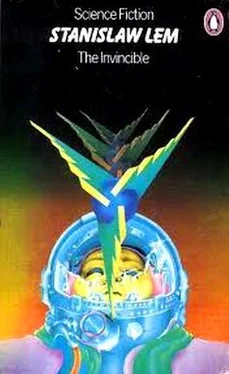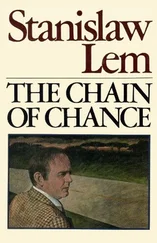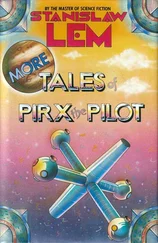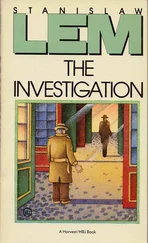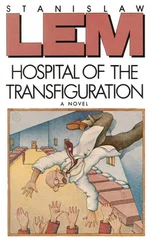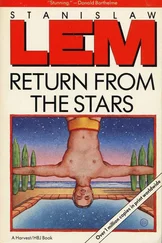“That reminds me of something,” said Gralew unexpectedly, as he screwed down the top of his thermos bottle. His thick black hair glistened in the light of the fluorescent lamp. “I’ll tell you about it, but don’t take it too seriously.”
“If it reminds you of anything at all, that means something,” replied Rohan with his mouth full. “Shoot!”
“It’s nothing special, really. I heard a story a long time ago, almost a fairy tale, about the inhabitants of the Lyre constellation.”
“Why a fairy tale? They did exist. Achramian even published a treatise about it,” remarked Rohan. A small bulb began to flicker behind them on the dashboard, a sign that contact had been established with the Invincible.
“Yes. Payne suspected some of the inhabitants may have succeeded in saving themselves in time. I’m not so sure that he is right there. They must have all perished when the nova exploded.”
“That took place sixteen light years from this planet,” said Gralew. “I don’t know the book. But I did hear somewhere that these people tried to escape. They presumably sent spaceships to all the planets of the other stars in their vicinity. They were well acquainted with the principle of space flight close to the speed of light.”
“And then?”
“That’s all I heard. Sixteen light years is not such an enormous distance. Why shouldn’t one of their spaceships have landed here?”
“Then you think they might still be somewhere around?”
“I couldn’t say. I was just reminded of them when I saw these ruins. They might have been their buildings, who knows?”
“What did they look like?” asked Rohan. “Did they resemble us?”
“According to Achramian, they did,” replied Ballmin. “But that is just another hypothesis. Practically no trace of them has survived, not even as much as from our own Pithecanthropus.”
“Strange.”
“Not at all. Their planet submerged for thousands of years in the chromosphere of the nova. Sometimes its surface temperature exceeded ten thousand degrees. Even the rocky foundation of the planetary crust underwent a complete metamorphosis. No trace remained of the oceans. The entire planet was thoroughly cooked. Just think of it, ten thousand years in the middle of the fires of a nova!”
“Then you really think it’s conceivable that some of these people might have survived here on Regis III? But why should they hide? And where could they be?”
“Perhaps they’ve died since then. I don’t know the answers. I simply voiced what crossed my mind when I saw these ruins.”
The men fell silent. Suddenly an alarm signal flared up on the dashboard.
Rohan jumped up and grabbed the headphones.
“Rohan here. What did you say? Oh, it’s you! Yes! Yes! I’m listening! All right, we’ll return at once!”
His face had turned pale. He turned to the rest and said: “Group II has found the Condor. About 180 miles from here.”
From a distance the rocket looked like a leaning tower. This impression was strengthened by the sand massed around it. Since the wind came from the west the sand wall had pulled up much higher than the east. Several tractors near the rocket had been almost totally buried by the sand. Even the antimatter mortar had been put out of action. It stood there with its hood raised, half filled with sand. But one could still see the jet openings at the ship’s nose which rested in an unobstructed depression in the ground. One had only to remove a thin layer of sand in order to reach the objects that lay strewn around the ramp.
The group stopped at the edge of the western dune wall. The vehicles they had brought along from the Invincible already ringed the area in a wide circle and the bunched rays of the emitters formed a protective energy screen. The men had left their transport vehicles and the info-robots about one hundred yards from the spot where the sand wall encircled Condor’s base. Now the men looked down onto the ridge of the dune.
The ramp was suspended about five yards above the ground, as if it had been suddenly stopped in midair while it was lowered downwards. The elevator, however, was untouched and its open door beckoned the men to enter. Nearby oxygen bottles stuck out from the sand. Their aluminum sheaths glistened brightly as if somebody had left them lying there just a few minutes earlier. Several steps further on, a blue object rested gleaming on the sandy ground. It was a plastic container, as they noticed on closer inspection. Everywhere inside the hollow around the foot of the spaceship was scattered a vast quantity of all kinds of things: cans of food, some full, some empty; theodolites, cameras, tripods, canisters, some still intact, others badly damaged.
As if someone had thrown the whole mess helter skelter out of the rocket, thought Rohan, and looked up at the darkened hole through which the crew would usually leave or enter the spaceship. The hatch was halfway open.
The small flying scouter robot that accompanied deVries’ expedition had found the dead spaceship quite by accident. DeVries had not tried to enter the Condor, but had immediately informed Horpach of his discovery. It had been decided that Rohan’s group would be the one to uncover the mystery that shrouded the Invincible’s sister ship. Now the technicians came running from their engines, lugging their toolboxes with them.
Rohan noticed something round on the ground, thinly covered by sand. With his foot he scraped away the fine sand, assuming he would dig up a small globe. Not suspecting anything, he kept on raking until he brought to daylight a pale yellow vault-like form. He recoiled rapidly, stifling a startled outcry. Alarmed, his companions turned around, looking at him. He held a human skull in his hand.
They found more bones and even a complete skeleton in a spacesuit. Between the dropping jaw and the upper teeth stuck the mouthpiece of the oxygen apparatus. The manometer had stopped at 46 atmospheres. Jarg knelt down and slowly turned the valve. The gas escaped with a hissing noise. Because of the dry desert air no trace of rust had formed on the metal parts of the reduction valve; it worked easily.
They entered the elevator but pushed the buttons in vain: there was no electrical current. It would be quite difficult to climb up the scaffolding of the elevator shaft and Rohan began deliberating whether to send up some of the men in a flying saucer robot. But in the meantime two men of the crew had already started their upward climb; they had secured themselves to each other by ropes as if they were mountain climbers. The rest of the group silently watched their ascent.
The Condor, a spacecruiser of the same class as the Invincible, had been built a few years earlier; externally, the two crafts could not be distinguished. The men were silent. Although none of them expressed the thought out loud, they all would have preferred to find the wreckage of a crash or even the aftermath of a nuclear explosion. They were all shaken by the sight of this ship in the sand, listing lifelessly to one side as if the ground had given way under the weight of the support pillars of the stern. There the apparently undamaged craft leaned in the midst of a confusion of objects and human bones; the men shuddered.
In the meantime the climbers had reached the entrance hatch, opened it fully and quickly disappeared from view. They remained there for a long while. Rohan was growing restless, when suddenly the elevator jerked upward for about one yard and then descended smoothly to the ground. At the same time the figure of one of the technicians became visible in the open door, beckoning to them to get in.
There were four of them going up in the elevator: Rohan, Ballmin, the biologist Hagerup and Kralik, one of the technicians. Out of habit, Rohan examined the mighty, rounded body of the ship that was gliding by behind the moving elevator. He was numbed with fear for the first time this day. The armored plates had been scratched and pitted by some incredibly hard tool. The marks were not especially deep, but so close together all over that the entire hull seemed to be dotted with small pox scars.
Читать дальше
